I am so glad that you are here with me, here at the end of all things. No, seriously: Check the Zelda timeline. Officially, this is the furthest point ahead in the series’ longest story branch. Future Hyrule, as we’ve seen, is kind of grim.
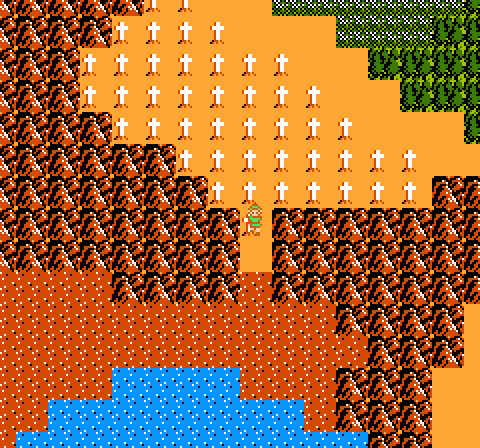
Case in point: The path forward to the end of The Adventure of Link is obscured by yet another graveyard. Remember the scale of the first game’s Hyrule within Zelda II‘s world map? This cemetery is vast.
With the sixth dungeon down and all six crystals placed in the statues within, you’re free to move ahead to the finale. Unlike in the original Zelda, the path to the end offers no ambiguity or mystery. While previous dungeons have required detective work, good luck, dogged persistence, and likely a strategy guide to uncover, the Great Palace sits in plain sight deep within the mountains. Technically, you can head to the Great Palace at any time after passing the River Demon, but the road ahead is fraught with invisible peril until you acquire the Cross to render the floating eyeball things visible.
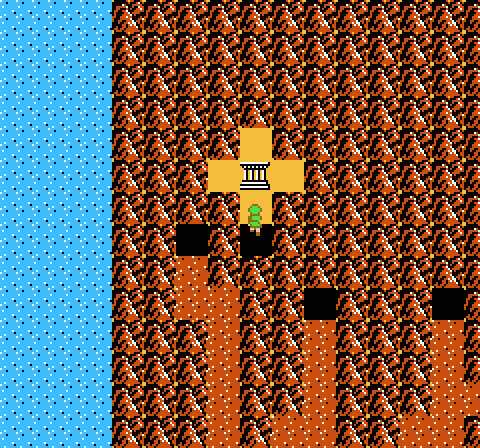
Even with your levels maxed and the Cross in hand, the road to the Great Palace yields a hard-fought victory. Thankfully the “lava” tiles in the mountains don’t hurt Link, just as the game’s swamp tiles don’t poison him. But the encounters along this road will beat you down. Simply reaching the Great Palace can burn through your stock of lives in short order.
In recognition of this fact, the Great Palace is the one point in Zelda II in which a Game Over doesn’t send you all the way back to the beginning of the game. Should you exhaust your lives here, you can continue from the entrance to the Palace. You’ll return to Princess Zelda’s side if you save and quit, but as long as you keep hitting continue, you can keep hitting your head against the dungeon’s proverbial wall in hopes of victory. This isn’t just a nicety; I can’t imagine possibly completing this game if you had to start from the beginning and worth through the mountain path every single time.
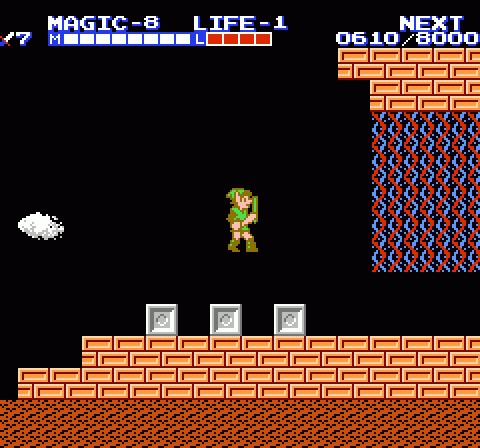
The entrance to the Great Palace repels visitors with a magical barrier that lifts only once you have placed all six crystals. You’ll also need all the Magic Containers scattered throughout the world — not to enter the Palace, but you can’t learn the magic spell required to win the final battle until you’ve maxed out your magic.
The Great Palace possesses both a unique color scheme and a special musical theme, much like Death Mountain in the first game. And, like Ganon’s Death Mountain hideout, the Great Palace is enormous, easily twice as large as any other Palace. Where it differs from the final labyrinth of the first game is that its size is strictly to make things hard on players. At this point, Link should have collected all his tools and spells and power-ups for the entire game, meaning you’ll find nothing here except sheer difficulty.
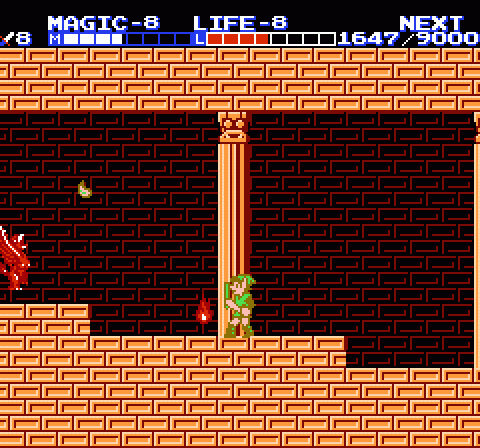
And what difficulty there is. Right away you’ll begin facing off against never-before-seen enemies, such as this Fokkeru (who tosses flames that sometimes land in a fixed position but can also unpredictably slide toward Link at random); in fact, the Great Palace offers more newly minted and unique foes than any dungeon since the first one. Again, this makes for an interesting contrast to Death Mountain: Whereas that maze offered only a single new monster (Patra) and revolved primarily around complex pathfinding and well-hidden essentials, the Great Palace leans entirely on brutal combat and long-term action game endurance.
While Zelda II may indeed be the ur-action RPG, at this point the RPG elements slip away and the remainder of the quest focuses on twitch reflexes, timing, and an awful lot of good luck. Even the most superficial of its RPG mechanics, the experience and leveling system, has no real meaning at this point: Wise players will have built up Link’s stats to a uniform level 8, and those who haven’t won’t do much progressing inside the Great Palace. The enemies within yield surprisingly little EXP despite their high difficulty, and the chances of surviving their onslaught long enough to hit high EXP requirements for the upper tiers of the leveling system are pretty slim.
That doesn’t stop EXP bonuses from dropping far more often than magic refills, though. If you’re at max levels, those EXP bags are like some kind of taunt, as Link can no longer level his stats once he hits 8. Should you somehow accumulate 9000 EXP, you can simply choose a free refill for Life or Magic when you see the “level up” interface. This is considerably less useful than blue and red pitchers.
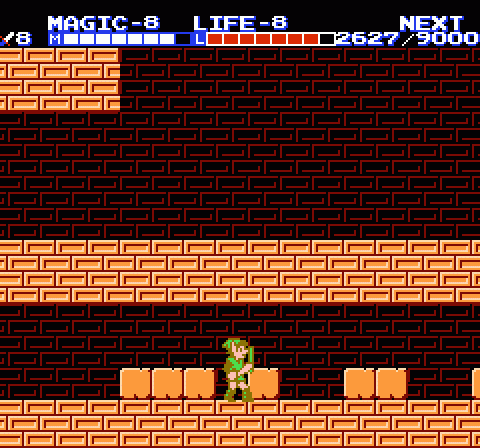
The Great Palace consists of a massive loop, with players free to travel either a left or right path into the depths. The left path sprawls across a much greater amount of real estate, but it’s a much clearer route to the end. The right path is considerably shorter (which means fewer horrible enemy encounters to whittle Link’s health down and defeat him through attrition), but its path is more oblique, with forward progress frequently disguised through situations such as this row of blocks that covers an invisible pitfall into the depths.
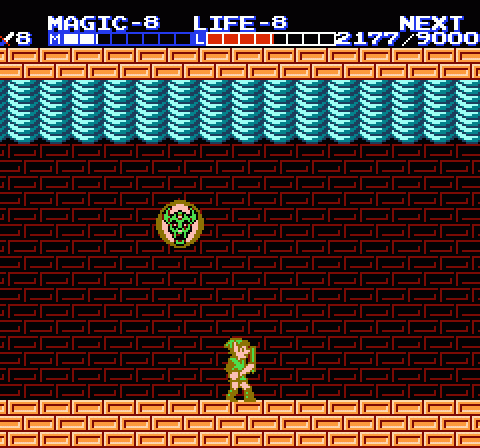
Among the new enemies in the Great Palace is the frightful-looking King Bubble, which is actually incredibly easy to avoid — and in fact offers no reason not to avoid it, since it yields no rewards upon defeat.
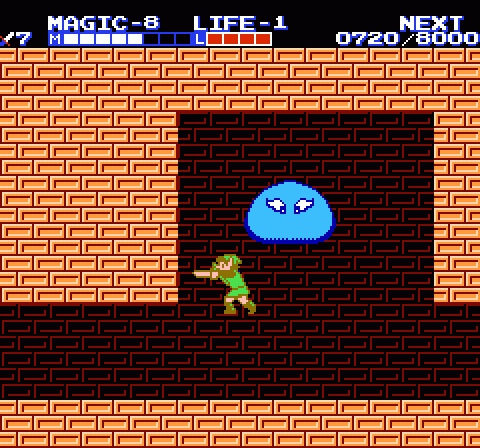
There’s also the Giant Bot, which appears from nowhere and drops from above as Link walks beneath it. This is basically a reverse King Slime from Dragon Quest in that striking it causes it to split into multiple normal Bots (rather than a bunch of Slimes gathering together to create the giant form). Though given that King Slimes wouldn’t debut until a few years after Zelda II, a better comparison might be the Zols in the original Zelda that burst into Gels when struck. The Bots in this Palace, however, take more hits to defeat than just about any other creature in the series.
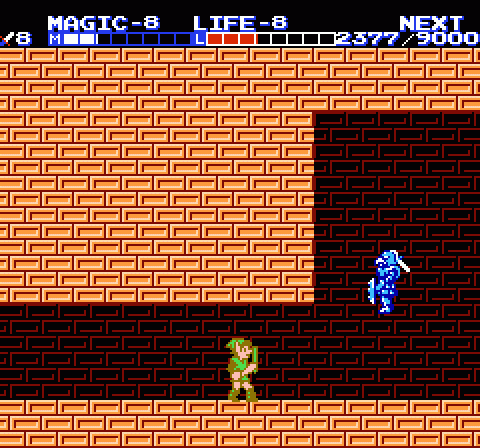
None of the new challenges put forward by the Great Palace put a seasoned player to the test like the absolutely brutal new upgrade to the Ironknuckle, Fokka. This image alone should be enough to send any Zelda II veteran into a cold sweat. These aren’t simply the most difficult enemies in Zelda II; they’re the toughest opponents in any Zelda, period.
Fokkas come in two colors (red and blue, per usual). The red ones are merely incredibly difficult; the blue ones can bring your game to an instant end if you’re unlucky.
At their basic level, Fokkas act like Blue Ironknuckles. They attack with sword and shield, blocking Link’s attacks with remarkably prescience and flinging sword beams quickly and with abandon. What makes a Fokka cause you to pine for the relative wussiness of a Blue Ironknuckle is the fact that they’re both airborne and evasive. It’s hard enough to sneak a sword strike through the knights’ shields, but it’s even harder when you can’t even get close enough to land a blow in the first place. As soon as you move into sword range with a Fokka, it leaps high into the air, usually over your head, and often while tossing a difficult-to-predict sword beam.
To make matters worse, Fokkas soak up at least as much damage as an Ironknuckle, possibly more; yet they yield very little EXP. They can absolutely ravage Link’s health in a matter of seconds. There is no reason to fight them besides bragging rights — and even if you choose to simply make a mad dash past them, you still can’t guarantee your own safety as they follow you persistently, tossing sword beams at the back of your head while you break through barriers barring your path to adjacent rooms.
Fokkas are Zelda II’s one final design misstep, a race of enemies that manage to be even more difficult than the final boss. Their evasiveness, endurance, obstructiveness, offensive power, and utter persistence makes them better suited to play the part of minibosses, but they’re not; they’re standard foes, and there’s no real reward for besting them. Ironknuckles make for great enemies for the way they can go toe-to-toe with Link on his own terms, but Fokkas commit the grave sin of being too much better than Link, lacking any weakness or even a reasonable exploit.
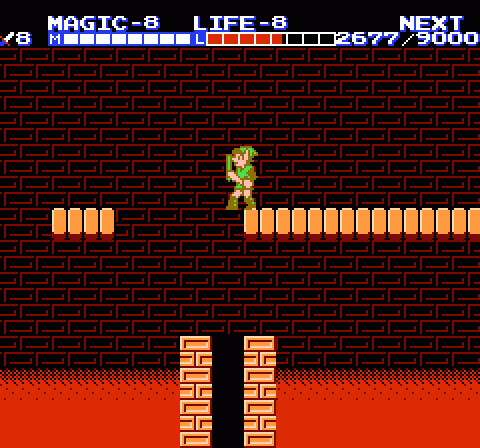
Finally, the path ahead to the end appears as a narrow shaft beneath a crumbling bridge and surrounded by lava. This drop is conspicuous in its insanity: Only a fool would jump down there, so obviously that’s where you need to go. I love this touch. Not only is it couched in Zelda II‘s design language, calling attention to itself with visual vocabulary that players have learned over the course of the six previous dungeons, it also creates a powerful sense of no return. Once you drop down that hole, there’s clearly no coming back.
You have perfectly captured and distilled the essence of Zelda II’s final dungeon in this write up. I can still feel the tension I had as a kid when I went through this hell hole many, many, MANY times. What a masochist I was to put myself through this. I never knew the official name for the bird knights but their name is perfect given the explicit choice words I would utter under my breath toward those things.
This level at first surprised me with it’s unique enemies (especially the Giant Bot and, of course, Fokka) but I felt that a good explanation for it existed within the game’s context. The Great Palace was sealed to hide the final piece of the Triforce. Within the seal, either the Triforce’s magic, the Triforce’s guardian’s (a sage?) magic, or just the general evilness of the palace, created the horrific monsters within. Or, the monsters already existed within and were sealed to prevent their escape… Either way, when that spell lifted from the Great Palace, I knew I was in for a great challenge.
The thing I hate about the Great Palace is that much of that real estate is a waste of space. There’s little incentive to gain experience, there are pitfalls that force you to replay large sections for no reason, and the path forward requires you to break a block to find a hidden pitfall - the one spot snare in my most recent playthrough that I couldn’t unravel by memories of past completions. Perhaps this is in keeping of the traditional idea of labyrinths/mazes - not every path is a useful one - but those hopping bird-things, like you say, are a mess to deal with, and backtracking through those is not fun.
This is why I always avoid picking up extra lives until I’m about to make my run for the Great Palace; that way, I have that much extra wiggle room when I go for it.
The reason the Great Palace starts you at the beginning of it, instead of back at North Palace, when you run out of lives? In the original Disk release of Zelda II it was the only playable content on its side of the disk! The Japanese release is different in several notable places from the US version; among other changes, you get more experience from late-game opponents, and no monster requires the Fire spell to kill.
When you get 9,000 points, not only do you get a free Life or Magic refill, but _you earn an extra life_.
Fokkeru: I love this name. It’s like a Romanization of _fuck you_. Same goes for Fokka. It’s fitting that these difficult opponents would have those names.
Like Ironknuckles can be beat relatively easily by stabbing when coming down from jumps, there’s a trick to Fokkas too, one that I discovered only recently from watching speedruns. These are the only enemies in the whole game where the sadly useless upthrust move is the key to beating them. Just block until they jump over you, then upstab. Before I learned that, I just got the hell past them whenever they showed up, and took the hits. But that’s not a symptom of bad design necessarily; why should you expect to be able to beat every enemy you encounter? Are Fokkas the hardest enemy in all of Hyrule? Well I’ve always hated the Moldorm in Link to the Past, probably the hardest boss in that game relative to when it appears….
The purpose of Fokkas in the game design is the same as that of the rock-throwing wall, of the obtuse secrets, of everything that’s challenging about Zelda II, and why I love it so much — _it forces players to rise to the occaision_. There are tricks to overcoming _all_ these things, and sheer game playing skill helps too. I personally vouch you can beat Zelda II without running out of lives, without even saving. I became able to do that because I worked at it. But I also had a lot of fun doing it. Zelda II isn’t a wall to beat yourself bloody against; it’s a wall to be *scaled*, and once you’re over it, you’re a better player.
(I’ve been trying to comment on these posts for _weeks_. The one-day-only period for commenting on posts is _greviously_ restrictive to people like me who find these posts a couple of days later through RSS.)
“Grievous”? That seems a bit strong.
So what are you planning to do after this? I’d like to see Bionic Commando, since I just finished it up myself.
hi-mi-tsu
I’m with John H. about the Fokkas—they’re a great example of how something that *looks* like a design misstep in Zelda II actually isn’t, necessarily, if you look at it more circumspectly. I didn’t actually know there was a trick to beating them, but even so I thought they were the game’s way of telling you that you shouldn’t necessarily try to fight everything. You also need to know when and how to try to get away.
One of my favorite things about Zelda II is that there are multiple ways to beat most of the enemies in the game, and there’s often no unique best one. You can use Reflect to block the fire attacks from Fokkerus, for instance, which makes them a lot easier. But should you do this? That depends on what kind of player you are: if you’re really good at dodging the fire attacks, Reflect’s not an efficient use of MP; if you’re really bad at blocking them, you might be better off just casting Shield. When you think about it, Zelda II is *constantly* requiring you to ask questions like this: it wants you to keep thinking about your particular skills as a player and what the most efficient way to deploy them is.
This, by the way, is why it’s not a design mistake at all that enemies only drop magic refills, never health. It forces you to think strategically about how best to use magic points to mitigate damage, which in turn forces you to keep thinking about your skills as a player. In any given encounter, you have to ask: “am I good enough to handle this room without taking a lot of damage?” If you’re not, the smart move is to cast Shield; if you are, you should save the magic points for casting Life down the road.
(Note that this is a really cool thing for any game to do, but *incredibly awesome* for a game whose WHOLE PLOT is about maturity, purification, and self-mastery, rather than defeating some external Big Bad.)
The depth of feeling behind my use of the word _grievous_ might become more evident once you read your email….
(Also: comments don’t seem to be rendering properly for me under Firefox. Is anyone else having that problem?)
Regarding comments on the previous entry… don’t know how I missed your statement on the villagers being helpful with ancient lore. Let’s just… forget that comment happened, right?
My trick with some of the Fokkas was to use blocks to get up high, and stab them as they jumped at me. I never thought about the upstab mentioned earlier.
These have been awesome to read, Jeremy. I wish I had the knack for game deconstruction that you have. There’s nothing like reading detailed analysis of a game that I have a love-hate-love again relationship with!
I wouldn’t go as far to say the Fokkas are a design misstep, but man do I run away from the blue ones as soon as they appear. They’re basically as strong as Link himself with the jump and fire spells activated. No point in dealing with that. Neat design though and I love the fact the game presents a bunch of new foes at the very end.
Also, hitting a Giant Bot with the upward thrust as it falls down feels good.
Some of the Fokkas appear in a room with several hollow columns of breakable blocks. I broke those blocks in a way that let me climb to the height of the Fokka’s jump and stabbed horizontally when he jumped. He’s apparently defenseless in the air.
The final parts of this game are just plain mean in a lot of places. It’s a definite change of pace from the typical Zelda final levels, which are usually pretty linear, easy, and unmemorable (with the exception of Zelda I). This is definitely the Zelda game I do the most running away from enemies in, including turning into a fairy to run through parts of the final palace.
I love this write-up. I haven’t explored the Great Palance since I first beat the game 25 years ago, and so I completely forgot about this Indiana Jones-style leap-from-the-lion’s head needed to get to the final boss(es).
I can’t remember exactly what happens next (a flashy fall into the Thunderbird’s chamber?) so I’m on the edge of my seat over here.
As John mentioned, the upward stab actually somewhat helped even the odds against the Fokkas.
I kind of wish the falling block + Moa room was saved for this palace instead of the not too hard 5th palace, if only for infinite free lives + magic refills. Heck, even the sixth palace, which was a battle of attrition.
I think one of the other daunthing things about this game was the limited nature of drops: it was an either/or proposition between magic and experience, and for any monster below 30 XP, all you got was a measly blue potion. Not to mention the dodgy 2 MP tax on the Life spell.
I don’t know if I can say much that hasn’t already been said here (except to echo the sentiments about the time window for comments and how they appear in Firefox), but I can’t wait for the next part!
I also hope you might offer an overview of sorts for how to make a new game like this work in today’s market. =) I love Zelda II and would love a new one like it, but I realize that some things would need to be changed. The game isn’t as bad as some say, but it could still be better.
Sorry, I’m not leaving comments open for any longer. As it is, I’m clearing out dozens of spam comments per post by the end of the brief open period.
There’s a trick to getting to the Great Palace that I stumbled upon years ago. If you can time a random enemy to hit you as you enter one of the forced encounter tiles in the swamp, you’ll enter a random battle instead of the predetermined platforming area. You can then flee the random battle and continue through the swamp having bypassed a difficult action setpiece.
I discovered this by accident years ago, and I’ve played the game several times since then and have never bothered to play through the action spaces again. God help you against the blue lizard men in the caves, though.
Ha, I used to do that as well. I don’t remember if I continued to in more recent playthroughs, though.
You know how most games fill the final level with all the enemies you have fought before? The Great Palace gave us new enemies (and a few trivial enemies on steroids). And they all were terrifying.
Nintendo really put a lot of effort into making the final level memorable. A level you would show your friends after school. A level many of us wouldn’t even reach.
Thanks for another great write-up, Mr. Parish.
I just noticed beneath the comment field here “Notify me of new posts by e-mail.” Is that talking about comments, or whenever there’s a new story? I’m giving that a try.
Also, meant to mention before: Those Giant Bots really freaked me out as a kid, probably more than anything else.
Also forgot to mention: I love how the tiles used for the Great Palace are the same ones used for Wart’s castle in Super Mario Bros. 2. When I was a kid, I thought there might be some sort of connection.